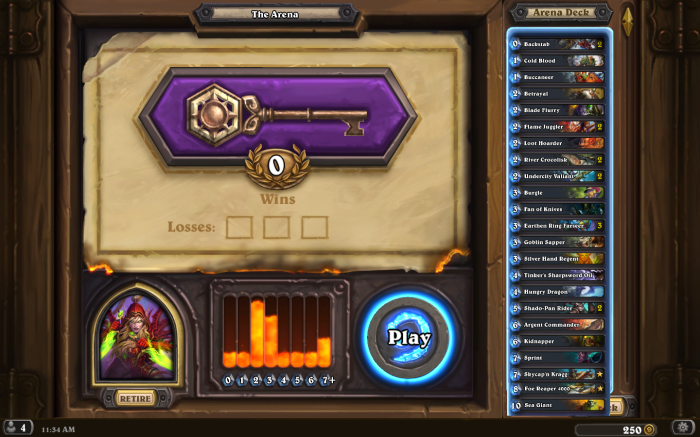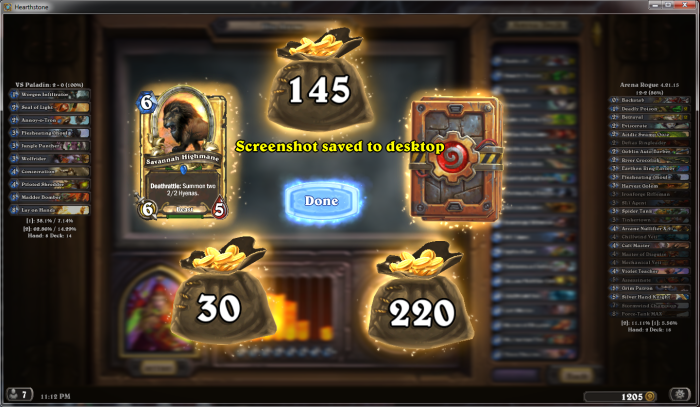In the last arena help post, I talk about general arena gameplay. While I believe gameplay has a larger bearing on arena success than the draft, the draft is also a very important component of it. Here are some basic arena drafting tips.

- Arena is not constructed – Good constructed decks usually work together as a collective synergy. 30 tight cards working together for the win. Arena decks are more like a ragtag bunch of misfits. In that sense, good constructed cards are not necessarily good arena cards. Chillwind Yeti, a card you probably used before you opened some booster packs, is a solid arena card. Paladin secrets that are not Avenge or Noble Sac work great with constructed Riddler Paladins. You probably don’t want to pick Repentance for no reason in the Arena.
- Mana curve – The term mana curve is thrown around a lot, and it isn’t exactly clear what a “good” mana curve is. It depends on an individual’s playstyle. Aggro players will have a big wall of 2-drops, a good amount of 1’s and 3’s and little after that. Midrangy-slower types would have something resembling a normal bell curve. Some players preach 4-drop consistency, and that does fit the midrange type of deck. It all comes down to making sure your deck has balance, and does not get too clunky.
- Value vs speed – Small drops typically have less value than bigger ones. This is typically because small minions die easier, and are less useful in the late game. There has to be a balance between value and speed in a draft. You can go all speed and low value, but you have to commit to going face the whole way. You can go all value and low speed, but you will likely be overrun by an opponent. The value-speed balance is typically reflected in the mana curve, where you can tell when the curve looks funny.
- Too much of a good thing is bad – Flamestrike is a high value card, and it is always a card you want to draft. But how many are too much? A deck with 7 Flamestrikes is probably going to get clogged up and wind up being bad. When picking high-value, high-cost cards, don’t take too many. But take a few.
- Good spells are premium – Your arena deck is going to have more minions than spells. Some decks are 0-spell beatdown machines. When you do see a good spell though, it is important to draft them. Ideally, you’ll want large removals, AOE, and small removals in your deck. Point 4 applies here as well. If you’ve drafted 2 Flamestrikes and are offered one again with Fireball or Frostbolt, you take the smaller-cost spell.
- 2-drops – I talked about how important controlling the board is in the arena. Typically, the first minions to get summoned in a game are 2-drops. It is important to have a good few 2-drops in any deck, so you can ensure presence in your opening hand. Nothing sucks more than getting minions that cost 4 or more in your opening. Fast decks have a ton of 2-drops, but it is good to have at least 6 in any.
- Twofers – A sign of a good card in the arena is one that trades 2-for-1. Chillwind Yeti’s typically can trade in with 2 3-drops. Bomb Lobber can kill something with the bomb, and clean up something after. Harvest Golems are great.
- Establish a win condition – Try to figure out a way to win with your deck. This could come in the form of a legendary minion, some inspire cards like Mukla’s Champion, a powerful spell like Savage Roar, etc. Having a win condition would not only help you win, but also will let you know if you are still in a game.
- Card cycling is useful – I struggle with card advantage often, so this is an important point. Topdecking against an opponent who has cards is almost a guaranteed loss. Have a few cards that either help your draw, or ones that can gain cards. The new Discover mechanic is good for card cycling.
- Synergies are good – An arena deck could have no synergy at all, or several variegated synergies. They come in handy in a pinch. Clockwork Knight for example, is a solid 5/5 that will give +1/+1 to a mech. This could allow your Spider Tank to survive Flamestrike (I know I mention this card a lot), which is crucial.
- The safe pick vs the sexy pick – The Arena gives people the chance to play cards they don’t have in their collection. The fun factor of the game does give a little leeway in swaying a fun pick. Before you make a decision, think if the difference between the cards you are choosing is worth it. If there isn’t too much risk, go for the sexy pick. If you feel the safe pick shores up a big void, then go safe. Typically, you want to go with the safe pick if you want to win. But for all other purposes, go with the flashy one.
- Draft cards you are comfortable with – Fel Reaver is a pretty good arena threat, but has a tremendous downside. It is probably a bad idea to draft a Fel Reaver just because it is considered good, but you are completely against the pick. Play cards you are comfortable with. This has some ties to the safe vs sexy pick, or what makes arena cards good.

